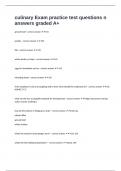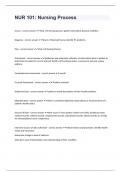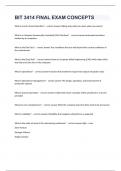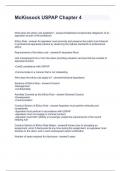Policy Analysis
Part 1: Methodology, Theory and context in public policy
research
Chapter 1: introduction: Why study public policy?
Public Policy Defined
Policy making is about constrained actors who attempt to match the policy goals with policy
means in a process that is most like applied problem-solving
- Two dimensions
o Technical dimension: optimal relationship between tools and goals
o Political dimension: the art of compromise between the different
stakeholders involved
- Definition of public policy
o Dye: Anything a government chooses to do or not to do
Primary agent of policy making: the government
There is a fundamental choice within governments to act or not to act
on a problem
Public policy is a constant conscious choice of a government
The unintended consequences are not by definition public
policy
o Jenkins: a set of interrelated decisions taken by a political actor or group of
actors concerning the selection of goals and the means of achieving them
within a specific situation where those decisions should be withing the power
of those actors to achieve
Policy is composed of a selection of goals and means
It involves a series of interrelated decisions and is therefore a dynamic
process
The capacity of the government to implement is an import addition
Public policy making as goal-oriented behavior
o Anderson: a purposive course of action followed by an actor or set of actors in
dealing with a problem or matter of concern for the population
Methodological implication for studying public policy
- Demanding task that goes further than reading official reports
o Most of the times the motivations for policy are hidden
- How to explain specific public policy outcomes
o Positivist view: there is a reasonably objective analysis of policy goals and
outcomes possible and those subjects can be explored with the basic social
science methodologies
Policy analysis: a concentration on the formal evaluation of policy
outcomes with quantitative techniques
o Post-positivist view: a more subjective interpretive to help discern and critique
government aims, intentions and actions
Policy studies: a broader perspective that looks further than effects but
also to the causes and presuppositions that led to the adaptation
,The Policy cycle framework: an applied problem-solving model of the policy process
The public policy making process can be simplified by thinking of it as a set of interrelated
stages through which policy issues and deliberations flow in a more or less sequential
fashion from inputs to outputs.
Overview of the models
- Lasswell 1971: seven stages of the policy progress
1. Intelligence: collection + disseminating knowledge
2. Promotion: supporting selected alternatives
3. Prescription: decision for an alternative
4. Invocation: decision of rules and selected alternatives
5. Application: implementation through the administration
6. Termination: ending the process
7. Appraisal: evaluation according to the initial goal
o Critics
Very little place for external influence of the policy making
Policy appraisal was placed after the termination while the evaluation
rather happens before termination
- Brewer 1974: six stages of the policy process
o Invention
The problem is sensed
o Estimation
Calculation of the risks, costs and benefits
o Selection
Adopting or rejecting some combination of the solution
o Implementation
o Evaluation
o Termination
o Difference with Lasswell
Evaluation before termination
Inclusion of external partners to the process
Introduced the notion of the policy process as an ongoing cycle
- Jones and Anderson 1984: five stages of the policy process
o Agenda setting
Problems come to the government
o Policy formulation
Formulation of policy options
o Decision-Making
The adaptation of a policy
o Policy implementation
Putting the policy into effect
o Policy evaluation
Looking critical to the policy
- Strength / advantages of the policy cycle model
o Helps to reduce complexity
o Mapping and clarifying the roles of actors, institutions and ideas/interests
- Limits / disadvantages
, o Non-systematic and idiosyncratic policy processes/decisions
o No linear order of the stages
o No clear notions about causes and effects of policy decisions
Chapter 2: Understanding Public Policy: Theoretical Approaches
Evolution of the Policy Sciences
Before World War Two the study of politics was focused on two broad subjects
1. The moral dimensions of government
a. Political philosophy
b. Political theory
2. Institutions of government
a. Empirical examinations of legislatures but ignoring the normative aspects of
the institutions
In the post war period it’s clear that a lot of scholars look for a new approach that connects
the examination of the government with the societal questions.
Policy science was one of those approaches that actually stood the test of time. It was
focused on what governments actually do and not what they should do. Lasswell (1951)
proposed three distinct characteristics for this new study
1. Multi-disciplinary
a. Policy science should break away from the narrow perspective of studying
institutions and political structures and should broaden the work with fields as
sociology, economics and law
b. The policy science nowadays has become it’s own study with it’s own
terminology therefore it still has the multi disciplinary aspects but they have
been more worked into the discipline of policy science
2. Problem solving
a. It adheres to the canon of relevance, orienting towards the solution of real
problems, not just engaging in academic debates
b. Easier said than done, the policy process on itself is so complex and the
political actors weren’t always open to hearing the expert ideas
3. Explicitly normative
a. The study should not cloak itself into the academic objectivity, when two
options should appear the science should be able to determine and say which
is best
b. The field has shifted to a more evaluative approach rather than a working
body to control the bigger goals themselves therefore this has become also
less relevant over time
In general the contemporary policy studies rely on one of two broad methods of analysis:
1. Deductive method: the understanding is developed largely on the basis of applying
concepts to specific phenomena
a. From theory to experiment
2. Inductive method: it develops generalizations only on the basis of observation and
empirical evidence
a. From experiment to theory
Approaches to Public Policy analysis: positivism and post-positivism
, Public policy is above all a very practical discipline with an explicit purpose to advise policy-
makers on how to address public problems. There again are two broad views of how to do
this properly: a positivist view that is based on economic principles and a post-positivist view
that counters the positivist view.
- Positivist approach
o Mostly the appliance of principles from welfare economics to public problems
The notion of market failures: The markets of the mainstream
economy don’t always work how they should do to circumstances. It’s
in these market failures that the government can act to supplement or
replace the markets
Public goods
o All goods and services can be placed into a schema of
four types based on two factors
Exclusivity: transactions involving a service
limited to the usage by a single consumer
Exhaustiveness: goods whose consumption
diminishes their availability to others
o Pure private goods: score high on both factors and can
be handled by the free market; food
o Pure public goods: score low on both factors and can’t
be handled by the free market: street lighting
o Toll goods: semi public goods that don’t diminish in
quantity after use but wherefore it’s possible to charge
for usage, can be handled by both government or free
market; bridges
o Common-Pool goods: the usage can’t be directly
charged to individuals but the quantity is reduced by
consumption, require a non-market; fish in the ocean
- EXCLUSIVITY EXHAUSTIVENESS
-
HIGH LOW
HIGH Private good Toll good
(e.g. foods) (e.g. highways)
LOW Common-Pool Public good
good (e.g. fish in
(e.g. street
ocean)
lightning)
Natural monopolies
o In certain industries the buy in costs are so high that it’s
basically impossible to do it, therefore the company
that’s first has the advantage and can create a natural
monopoly without regulation
Part 1: Methodology, Theory and context in public policy
research
Chapter 1: introduction: Why study public policy?
Public Policy Defined
Policy making is about constrained actors who attempt to match the policy goals with policy
means in a process that is most like applied problem-solving
- Two dimensions
o Technical dimension: optimal relationship between tools and goals
o Political dimension: the art of compromise between the different
stakeholders involved
- Definition of public policy
o Dye: Anything a government chooses to do or not to do
Primary agent of policy making: the government
There is a fundamental choice within governments to act or not to act
on a problem
Public policy is a constant conscious choice of a government
The unintended consequences are not by definition public
policy
o Jenkins: a set of interrelated decisions taken by a political actor or group of
actors concerning the selection of goals and the means of achieving them
within a specific situation where those decisions should be withing the power
of those actors to achieve
Policy is composed of a selection of goals and means
It involves a series of interrelated decisions and is therefore a dynamic
process
The capacity of the government to implement is an import addition
Public policy making as goal-oriented behavior
o Anderson: a purposive course of action followed by an actor or set of actors in
dealing with a problem or matter of concern for the population
Methodological implication for studying public policy
- Demanding task that goes further than reading official reports
o Most of the times the motivations for policy are hidden
- How to explain specific public policy outcomes
o Positivist view: there is a reasonably objective analysis of policy goals and
outcomes possible and those subjects can be explored with the basic social
science methodologies
Policy analysis: a concentration on the formal evaluation of policy
outcomes with quantitative techniques
o Post-positivist view: a more subjective interpretive to help discern and critique
government aims, intentions and actions
Policy studies: a broader perspective that looks further than effects but
also to the causes and presuppositions that led to the adaptation
,The Policy cycle framework: an applied problem-solving model of the policy process
The public policy making process can be simplified by thinking of it as a set of interrelated
stages through which policy issues and deliberations flow in a more or less sequential
fashion from inputs to outputs.
Overview of the models
- Lasswell 1971: seven stages of the policy progress
1. Intelligence: collection + disseminating knowledge
2. Promotion: supporting selected alternatives
3. Prescription: decision for an alternative
4. Invocation: decision of rules and selected alternatives
5. Application: implementation through the administration
6. Termination: ending the process
7. Appraisal: evaluation according to the initial goal
o Critics
Very little place for external influence of the policy making
Policy appraisal was placed after the termination while the evaluation
rather happens before termination
- Brewer 1974: six stages of the policy process
o Invention
The problem is sensed
o Estimation
Calculation of the risks, costs and benefits
o Selection
Adopting or rejecting some combination of the solution
o Implementation
o Evaluation
o Termination
o Difference with Lasswell
Evaluation before termination
Inclusion of external partners to the process
Introduced the notion of the policy process as an ongoing cycle
- Jones and Anderson 1984: five stages of the policy process
o Agenda setting
Problems come to the government
o Policy formulation
Formulation of policy options
o Decision-Making
The adaptation of a policy
o Policy implementation
Putting the policy into effect
o Policy evaluation
Looking critical to the policy
- Strength / advantages of the policy cycle model
o Helps to reduce complexity
o Mapping and clarifying the roles of actors, institutions and ideas/interests
- Limits / disadvantages
, o Non-systematic and idiosyncratic policy processes/decisions
o No linear order of the stages
o No clear notions about causes and effects of policy decisions
Chapter 2: Understanding Public Policy: Theoretical Approaches
Evolution of the Policy Sciences
Before World War Two the study of politics was focused on two broad subjects
1. The moral dimensions of government
a. Political philosophy
b. Political theory
2. Institutions of government
a. Empirical examinations of legislatures but ignoring the normative aspects of
the institutions
In the post war period it’s clear that a lot of scholars look for a new approach that connects
the examination of the government with the societal questions.
Policy science was one of those approaches that actually stood the test of time. It was
focused on what governments actually do and not what they should do. Lasswell (1951)
proposed three distinct characteristics for this new study
1. Multi-disciplinary
a. Policy science should break away from the narrow perspective of studying
institutions and political structures and should broaden the work with fields as
sociology, economics and law
b. The policy science nowadays has become it’s own study with it’s own
terminology therefore it still has the multi disciplinary aspects but they have
been more worked into the discipline of policy science
2. Problem solving
a. It adheres to the canon of relevance, orienting towards the solution of real
problems, not just engaging in academic debates
b. Easier said than done, the policy process on itself is so complex and the
political actors weren’t always open to hearing the expert ideas
3. Explicitly normative
a. The study should not cloak itself into the academic objectivity, when two
options should appear the science should be able to determine and say which
is best
b. The field has shifted to a more evaluative approach rather than a working
body to control the bigger goals themselves therefore this has become also
less relevant over time
In general the contemporary policy studies rely on one of two broad methods of analysis:
1. Deductive method: the understanding is developed largely on the basis of applying
concepts to specific phenomena
a. From theory to experiment
2. Inductive method: it develops generalizations only on the basis of observation and
empirical evidence
a. From experiment to theory
Approaches to Public Policy analysis: positivism and post-positivism
, Public policy is above all a very practical discipline with an explicit purpose to advise policy-
makers on how to address public problems. There again are two broad views of how to do
this properly: a positivist view that is based on economic principles and a post-positivist view
that counters the positivist view.
- Positivist approach
o Mostly the appliance of principles from welfare economics to public problems
The notion of market failures: The markets of the mainstream
economy don’t always work how they should do to circumstances. It’s
in these market failures that the government can act to supplement or
replace the markets
Public goods
o All goods and services can be placed into a schema of
four types based on two factors
Exclusivity: transactions involving a service
limited to the usage by a single consumer
Exhaustiveness: goods whose consumption
diminishes their availability to others
o Pure private goods: score high on both factors and can
be handled by the free market; food
o Pure public goods: score low on both factors and can’t
be handled by the free market: street lighting
o Toll goods: semi public goods that don’t diminish in
quantity after use but wherefore it’s possible to charge
for usage, can be handled by both government or free
market; bridges
o Common-Pool goods: the usage can’t be directly
charged to individuals but the quantity is reduced by
consumption, require a non-market; fish in the ocean
- EXCLUSIVITY EXHAUSTIVENESS
-
HIGH LOW
HIGH Private good Toll good
(e.g. foods) (e.g. highways)
LOW Common-Pool Public good
good (e.g. fish in
(e.g. street
ocean)
lightning)
Natural monopolies
o In certain industries the buy in costs are so high that it’s
basically impossible to do it, therefore the company
that’s first has the advantage and can create a natural
monopoly without regulation








